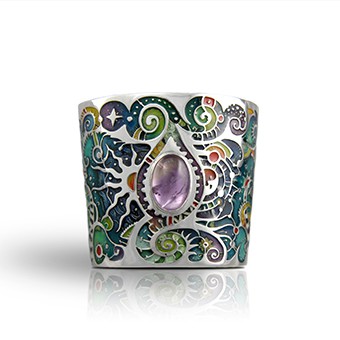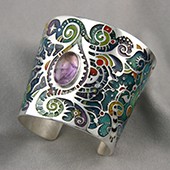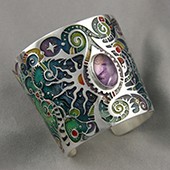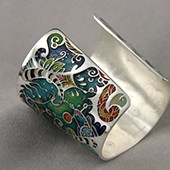Mad Hatter Cuff by Liz Sabol |
Home > Winners > #47910 |
 |
|
||||
| DESIGN DETAILS | |||||
| DESIGN NAME: Mad Hatter PRIMARY FUNCTION: Cuff INSPIRATION: After successfully developing a process to translate my signature organic designs into a series of flat round pendants, I wanted to see far I could take the concept. How large of a piece could I make with this technique? Could it be curved enough to make a dramatic cuff? With such a large canvas, how fantastical could I depict a surreal dimension? UNIQUE PROPERTIES / PROJECT DESCRIPTION: Cuff: Hand-Painted, Resined Champleve. 960 Sterling (PMC). Amethyst Cabochon. A wonderland-like juxtaposition and interweaving of flowing forms and color, delving down a hierarchy of details - every gaze discovering yet a new level of fantasia. OPERATION / FLOW / INTERACTION: Decorative Cuff, worn on the wrist or lower forearm. PROJECT DURATION AND LOCATION: From Aug 2015 to Jan 2016, Pittsburgh, USA |
PRODUCTION / REALIZATION TECHNOLOGY: 960 Sterling (mix of PMC3 and PMC Sterling metal clay), Oil Paint, Resin. I begin with sketching on paper. I scan the drawing & redraw on the computer to refine the edges and add additional details. Then I cut a mold of the design in Plexiglas using an etching laser. After forming the silver clay in the plexiglas mold, it is fired in a kiln. I then use traditional techniques of forming, polishing, soldering & stone setting. With tiny brushes, I paint the recesses with oil paint. I uncover the tiny details with a burnisher, then seal the color by applying resin with a toothpick. SPECIFICATIONS / TECHNICAL PROPERTIES: Width 71 mm x Depth 60 mm x Height 62 mm TAGS: cuff, silver, sterling, amethyst, color, champleve, jewelry, fantasia, organic, flowing, bracelet, 960, PMC, metal clay, sintered RESEARCH ABSTRACT: How to apply very complex color designs in a permanent method to metal, other than using enamel. Initial tests utilized Guilders paste and sealing with a 2-part epoxy resin. The negatives were difficulty of application, limited color pallet, and chemical fumes. Colored pencils were promising, but impossible to apply to tiny recesses. Subsequent tests with artist oils proved better on all issues, supplying a diverse color pallet, better bonding with the metal, easy application, no negative reaction with the resin. CHALLENGE: Rolling out such a large piece of clay and obtaining a clean impression from the large mold was very difficult. The clay was getting trapped in the mold. The solution ended up being a combination of discovering a better release agent for the mold, and reducing the impression time. The cuff needed to be formed prior to resin application, presenting a curved surface. To keep the resin from flowing out of the wells, the solution was to incorporate design elements around the circumference of the cuff, to create boundaries for containing the resin. ADDED DATE: 2016-03-09 17:12:25 TEAM MEMBERS (1) : IMAGE CREDITS: All Submission Images: Liz Sabol, 2016 Artist Profile Photo: Shana Selway, 2016 PATENTS/COPYRIGHTS: Copyright Liz Sabol, Bead Lizzy, Liz Sabol Creative. |
||||
| Visit the following page to learn more: http://www.beadlizzy.com | |||||
| AWARD DETAILS | |
 |
Mad Hatter Cuff by Liz Sabol is Winner in Jewelry Design Category, 2015 - 2016.· Press Members: Login or Register to request an exclusive interview with Liz Sabol. · Click here to register inorder to view the profile and other works by Liz Sabol. |
| SOCIAL |
| + Add to Likes / Favorites | Send to My Email | Comment | Testimonials | View Press-Release | Press Kit |







